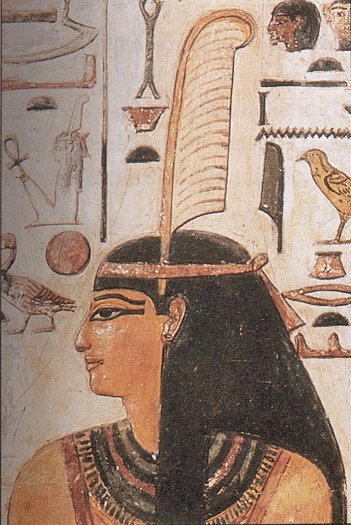Although she was often personified, Maat (Ma’at) is perhaps best understood as an idea, rather than a goddess, but she was central to conceptions of the universe, balance, and divine order in Ancient Egypt.
The name Ma’at is generally translated as “that which is straight” or “truth” but also implies “order”, “balance” and “justice”. Thus Ma’at personified perfect order and harmony. She came into being when Ra rose from the waters of Nun (Chaos) and so she was often described as a daughter of Ra. She was sometimes considered to be the wife of Thoth because he was a god of wisdom.

The ancient Egyptians believed that the universe was ordered and rational. The rising and setting of the sun, the flooding of the Nile, and the predicable course of the stars in the sky reassured them that there was permanence to existence which was central to the nature of all things. However, the forces of chaos were always present and threatened the balance of Maat. Each person was duty bound to preserve and defend Maat and the Pharaoh was perceived as the guardian of Maat. Without Ma’at, Nun would reclaim the universe and chaos would reign supreme.
The Egyptians also had a strong sense of morality and justice. They felt that the good should prosper, and that the guilty would be punished. They praised those who defended the weak and the poor and placed a high value on loyalty, especially to one’s family. However, they also understood that it was not possible to be perfect, just balanced.

Maat transcended specific ethical rules (which differed according to different times and different peoples) and instead focused on the natural order of things. That being said, certain actions were clearly against Maat as they increased the effect of chaos and had a purely negative effect on the world.
Each Egyptian’s soul was judged in the Hall of Maat (depicted in the book of the dead and book five of the Book of Gates) when they died. Their heart (conscience) was weighed against the feather of Ma’at (an ostrich feather) on scales which represented balance and justice. If their heart was heavier than the feather because they had failed to live a balanced life by the principles of Ma’at their heart was either thrown into a lake of fire or devoured by a fearsome deity known as Ammit. If, however, the heart balanced with the feather of Ma’at they would pass the test and gain eternal life. At certain times it was Osiris who sat as judge in the ritual, and many other deities were involved in the ceremony, but the scales always represented Maat.

00The Ancient Egyptians also had a well developed legal system to ensure that Maat was preserved in daily life. It is thought that the Priests of Maat were involved in the justice system, as well as tending to the needs of the goddess. Pharaohs were regularly depicted “presenting Ma’at” (holding out a tiny statue of the goddess) to reiterate their commitment to upholding order and justice.
All rulers respected Ma’at, but Akhenaten in particular emphasised his adherence to Ma’at, despite (or perhaps because of) his rather unconventional approach to the gods. Hatshepsut also emphasised her reverence for Maat by taking the throne name Ma’atkare (justice is the soul of re), again possibly because, as a female ruler, she needed to show that her position was in line with Ma’at. She also built a small temple to Ma’at within the precinct of Montu in Karnak.



Maat was depicted as a woman wearing a crown with a single ostrich feather protruding from it. She is occasionally depicted as a winged goddess. Her totem was a stone platform representing the stable foundation on which order was built and the primeval mound which first emerged from the waters of Nun (chaos).
Bibliography
- Bard, Kathryn (2008) An introduction to the Archaeology of Ancient Egypt
- Kemp, Barry J (1991) Ancient Egypt: Anatomy of a Civilisation
- Pinch, Geraldine (2002) Handbook Egyptian Mythology
- Redford Donald B (2002) Ancient Gods Speak
- Robins, Gay (2008) The art of Ancient Egypt
- Watterson, Barbara (1996) Gods of Ancient Egypt
- Wilkinson, Richard H. (1992) Reading Egyptian Art
- Wilkinson, Richard H. (2003) The Complete Gods and Goddesses of Ancient Egypt
- Wilkinson, Richard H. (2000) The Complete Temples of Ancient Egypt
Copyright J Hill 2008